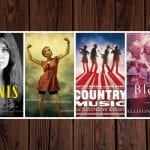Drumming for the Dead: Bill Kreutzmann’s Memoir of His 30 Years with the Grateful Dead
Over three nights in early July, thousands of Deadheads will flock to Soldier Field in Chicago to let the sweet sounds of “Ripple” wash over them, dance to the pungent rhythms of “Sugar Magnolia” and “Uncle John’s Band,” and celebrate the entrancing music that entered their souls 50 years ago, filling them with an everlasting wanderlust and an unquenchable love for the cascading riffs and trills that still transport them to other worlds. The thousands of Deadheads lucky enough to get tickets to the shows at the stadium will be joined by thousands of others dancing in the aisles of local movie theaters as the “Fare Thee Well” tour – which coincides with the Dead’s final show in the same venue 20 years ago – are streamed live.
Bill Kreutzmann, who’s been playing drums with the band from its very first rehearsal to its final gig, sums up the influence of the Grateful Dead in the very first pages of his new memoir, Deal: My Three Decades of Drumming, Dreams, and Drugs with the Grateful Dead (St. Martin’s): “During those three decades, we sold millions of albums and moved even more concert tickets. We toured the world and played thousands of shows … A nation of Deadheads followed us wherever we went, bearing torches lit from the flames of the 1960s … We weren’t just a band; we were a community, a culture. We became a brand and a lifestyle. And Jerry Garcia was our leader, our nucleus, our heart.”
Like one of the Dead’s noodling, meandering, free-form jams, Kreutzmann’s memoir wanders capriciously from one moment to the next, never settling long on any particular aspect of his life or loves. He celebrates every high and low of his ride on this long, strange trip, dispensing small doses of drumming and dreams, and a large dose of drugs.
When he was 13 or 14, Kreutzmann discovered his destiny as a rock and roll drummer while he was just playing around for fun in front of some friends. When the little band grooved on “Johnny B. Goode,” he experienced the first joyful moment of his life; “I was given the gift of finding something that was so clearly my passion, it was undeniable,” he writes.
When his father picked him up and saw in his sons eyes the unmistakable light of doing something he really loved, he told the young Kreutzmann that he wouldn’t make any money at playing music. Kreutzmann simply replied that he hadn’t even thought of that. It’s one of the ironies of the book, of course, that while playing music forms the joyous warp and woof of the Dead’s living fabric, they’re also the canniest businessmen on the planet, raking in millions – still – every year.
Even so, Kreutzmann’s ecstasy in finding his passion so young soon evolved into pure joy as he joined his second band.
When he was 16, Kreutzmann saw Jerry Garcia playing banjo in a band called Mother McCree’s Uptown Jug Champions. “Right then,” he writes, “I became the first Deadhead because I said, ‘I’m going to follow this guy forever.’” Garcia clearly noticed this kid sitting spellbound right in front of him because he called two weeks later and asked Kreutzmann if he wanted to play in a band; that band, which started out as The Warlocks, of course became the Grateful Dead, and the rest is rock and roll history.
Deal plays like an insider’s home movies of life amongst the Dead. Kreutzmann treads chronologically through his life in and out of the band, offering memorable highlights of the people, places, songs, and events that he and the others went truckin’ through from May 1965 onward. He recalls that in 1970 Robert Hunter became a member of the band in his own right: “His words became the words of the Grateful Dead, and when people quote us, they’re usually quoting him.” Indeed, the Garcia-Hunter songwriting partnership became as productive a relationship in its own way as Boyce and Hart, Geffen and King, Lennon and McCartney.
Kreutzmann reveals his utter stage fright – throwing up before the band went on; his left hand locking up during the their set – at Monterey Pop in 1967, where the Dead were sandwiched on the bill between The Who and the Jimi Hendrix Experience. He recalls his introduction to Mickey Hart, who eventually joined the band and taught him the rudiments of drumming that Kreutzmann incorporated and then transcended. He offers a tribute to promoter Bill Graham’s genius: “One thing was uniquely Graham’s … the way he’d string a lineup together for a show. He wanted to educate his audience … he’d take the hip new thing and put them on a ticket with overlooked royalty, introducing young crowds to the masters. He’d bill upstarts next to immortals.”
He reflects on each of the band’s albums. “Workingman’s Dead was all about discovering the song,” he writes. “Half a year later, American Beauty became all about having the harmonies to do that.”
On Anthem of the Sun, Phil Lesh and Jerry Garcia wanted to capture the quality and spirit of the Dead’s live performances, which included long improvisational jams. The band started playing the album sequence live at every stop along the tour, and then Garcia and Lesh went into the studio and like “mad scientists started splicing all the various live versions of the songs together.”
Ever innovators – or at least ardent experimenters both with music and drugs – the band wrote “The Eleven,” which takes a 12/8 time measure and subtracts an eighth note to make it 11/8. Kreutzmann notes that the Allman Brothers soon after released one of their songs, “Whipping Post,” with the same time signature.
Plenty has been written about the religious or spiritual quality of the Grateful Dead’s music. Some writers have gone so far as to compare the Dead and the Deadheads with a cult or an organized religion. While there may well be similarities, and while the music may indeed offer transcendent moments to the gathered audiences, Kreutzmann offers his own take on the matter: “Jerry Garcia was not the messiah. We were there every night for the same reason the Deadheads were. We wanted the music to take us to a place of transcendence and elegance. We wanted to reach that group consciousness so that we could realize that there was something that was bigger than us – and whatever IT was, we all were an equal part of it.”
As he looks back, Kreutzmann traces the arc of the Dead’s life until the early 1990s when the bottom started to drop out: “During the 1960s,” he writes, “we were just a bunch of kids with our own ideas about what you could do with rock ‘n’ roll music. During the 1970s, we became the Grateful Dead. During the 1980s, we became genuine rock stars. From seed to flower to fruit.”
After Garcia’s death in 1995, the band kept driving that train in various incarnations, though the spirit has since vanished and the driving genius behind the musical organism has left the body. Kreutzmann admits that when he hears the Grateful Dead’s music now, “it transforms me and it heals me. And it redeems me. But it also makes me miss Jerry.”
Kreutzmann also admits that when he met his wife, Aimee, it changed his life, and he concludes that his book is really more of a simple love story about letting your heart guide you through an incredible journey. What an incredible journey it’s been, of course, and Deadheads will certainly want to add this book to their Dead stashes.
Ultimately, though, Kreutzmann’s autobiography is just one more pedestrian tale of the life and high times in the heady days ruled by sex, drugs, and rock and roll, and it’s told in flat-as-pavement prose that can’t nearly begin to capture the joyous quality of Kreutzmann’s own powerful drumming or his enduring contributions to the Dead’s music.




